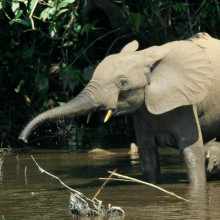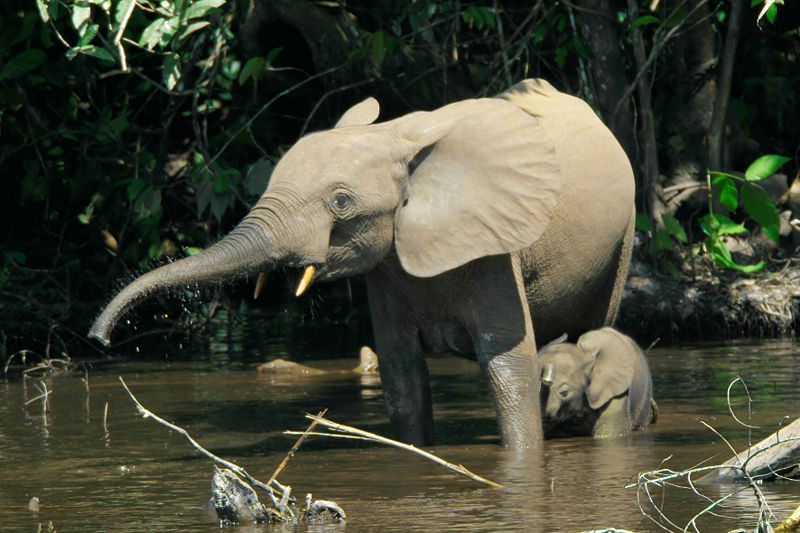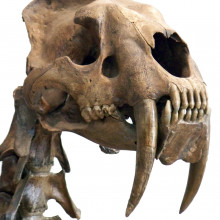This week, we discover how the 2004 Boxing Day Tsunami is the latest in a history of tsunamis in that area, why elephants who avoid roads to avoid poachers could be causing problems for the species as a whole, and a new system of lenses that allows us to take 360 degree photos inside our bodies! Plus, why Saber-Tooth Tigers hunted in packs!
In this episode

Son of Tsunami
The Boxing Day tsunami has several predecessors, scientists have found. Two papers in this week's Nature by Geoscience Australia researcher Amy Prendergast and team, and Kent State University Ohio scientist Katrin Monecke and colleagues have found evidence for at up to three previous massive tsunami events in the Indian Ocean. Both teams made their discoveries by taking core samples from marshy ridges behind the modern-day beaches in parts of Thailand and Sumatra respectively. The theory was fairly straight forward. Sudden large in-shore movements of water carry with them large amounts of sand and gravel which are then deposited uniformly wherever the water goes, covering the ground like a thin layer of icing. Over time these deposits are covered by soil and other materials as the flooded area recovers and returns to normal. But the gravel layers remain like "tsunami tide-marks" for centuries and can be pinpointed in time by carbon-dating material buried within the deposits and by other geological techniques such as looking at the rate at which the beach ridges have advanced. The teams found deposits consistent with up to three previous tsunamis including one likely to have happened in 1907 and for which there is a strong historical record. The other two occurred at around 700 years ago and the third about 1300 years ago. At the two sampling locations studied by the researchers the waves would have been up to 35 metres high when these events occurred. Previously there was thought to be no historical precedent for the 2004 tsunami; now we know differently. But what's still an issue, the researchers point out, is what this means to the people of Sumatra and elsewhere who live beside this threat.
Nanotube speakers
Conventional loudspeakers work by passing a current though a coil near a magnet. The current creates its own magnetic field and so is pushed or pulled by the magnet. If you keep changing the current you will move the coil backwards and forwards creating vibrations in the air, and with the right set of currents, music. However, as you have probably noticed loudspeakers are large and unwieldy things.
Chinese researchers may have come up with an alternative. They have produced sheets of roughly-aligned 10 nanometre carbon nanotubes. They then applied an electric current to the fabric and sound came out. This was quite surprising so they tried to work out what was causing the sound. They shone lasers at the surface of the material and it appears that it isn't actually moving. What is happening instead is that it is heating and cooling from room temperature to 80 Celsius hundreds of times a second. This heats and cools the air close to it which causes it to expand and contract: creating vibrations and therefore sound.
This is not a new effect. It was first noticed over a hundred years ago by passing large currents though platinum foils. However, because it takes a lot of energy to heat up platinum it was immensely inefficient. It takes 260 times less energy to heat up this nanotube material by 1°C and it has a large surface area. As a result it efficiently heats the air and will work a lot better.
The material is transparent so it could be added to the front of an LCD screen on a phone and it is flexible so it could be placed on curve.

Clever elephants have learned to avoid roads
Forest elephants living in West Africa's Congo Basin have learned to avoid roads probably because they realise that where there are roads there are poachers with guns.
That's according to a study published in the online journal Plos ONE, led by Stephen Blake from the Wildlife conservation Society. Blake and his team have shown that by avoiding roads elephants are confining themselves to smaller and smaller patches of habitat which could spell even more trouble for this endangered species.
 The research team put collars on 28 elephants with Global positioning tracking systems and followed their movements through the forests of the Congo Basin. It became clear to them that elephants avoid roadways even in areas where poachers are kept out. During the whole study only a single elephant was recorded crossing a road and, when it did, it dashed across at 14 times its normal pace.
The research team put collars on 28 elephants with Global positioning tracking systems and followed their movements through the forests of the Congo Basin. It became clear to them that elephants avoid roadways even in areas where poachers are kept out. During the whole study only a single elephant was recorded crossing a road and, when it did, it dashed across at 14 times its normal pace.
We might assume that if intelligent elephants have learned to avoid roads and poachers then this is a good thing because fewer of them will be shot.
But the problem is that the current book in road building is carving up the remaining areas of intact forest and the areas that elephants live in are contracting. It may be that elephant herds will not be able to find all the food and resources they need to survive.
There could even be a knock-on effect on the forest ecosystems since it is thought that when elephants roam large areas they play an important role in seed dispersal. This could be disrupted if they only live in small, separate patches of forest.
The good news is the research team have suggested that some relatively simple and cheap planning measures could be introduced that would make a real difference for the elephants. By planning exactly where roads go and trying to keep intact areas of forest that are as large as possible we should be able to minimise how much elephants continue to be confined by their fear of roads.

Hybrid camera helps to see in more directions
Digital cameras are brilliant at looking in one direction, which is normally what you want to do, but sometimes you need to see to the sidesas well.
 The conventional solution to this problem is normally either to build a moving camera that can look in different directions or to use a fisheyelens. This is a large, almost hemispherical lump of glass which will bend the light from the sides onto your camera. The problem is that these areboth large and heavy.
The conventional solution to this problem is normally either to build a moving camera that can look in different directions or to use a fisheyelens. This is a large, almost hemispherical lump of glass which will bend the light from the sides onto your camera. The problem is that these areboth large and heavy.
Insects solve this problem by essentially having thousands of separate lenses pointing in different directions: each producing one pixel of animage. Previously this has been tried but it is difficult to make and you tend to end up with a very low resolution image.
Engineers at BAE systems have built a hybrid solution which involves about 9 lenses pointing in different directions. These focus light into a seriesof optical fibres which bend the light onto a light-sensing chip. Software is then used to build up an image that makes sense. This means that youcan have a high resolution and see to the sides in an object about the size and weight of a sugarlump.
They are intending on using it first on missiles which can then hit a moving target more easily. But they say it could also be useful forlooking at confined spaces such as on the end of an endoscope used to look into body cavities.

Sabre-tooth tigers hunted in packs
Take a step back to the time when sabre-toothed tigers roamed the land. A new study has suggested these toothy predators were not lone hunters but may in fact have lived in packs like many social carnivores do today.
That's according to Chris Carbone from the Zoological Society of London and his colleagues writing in the journal Biology Letters this week.
The unusual thing Carbone and his colleagues did was to study modern day carnivorous cats in Africa to help understand what their ancient ancestors were doing thousands of years ago.
Ancient tar pits in Los Angeles, the Rancho La Brea, contain the fossilised remains of over 2000 sabre-toothed tigers: the cats had come to the tar pits to feed on prey that had got caught in the sticky tar. The researchers wondered whether all these cats came individually or whether they came together in a pride.
As a way of investigating this, they played back the recorded sounds of prey animals in distress both in the Serengeti region of Tanzania and Kruger National Park in South Africa. There were the same sorts of sounds that the sabre-tooth tigers would have heard thousands of years ago, from wailing prey animals trapped and dying in the tar pits. What they found was that the number of large social carnivores turning up to the recordings was much greater than would be expected based on the overall population size. Around 84 % of the animals that came to check out the noise were lions and hyenas, both social animals.
And the sabre-tooth tigers appeared in a comparable proportion at the Los Angeles tar pits. Along with another animal called the dire wolf, they made up the same 84% as was seen in modern-day Africa; hinting that they too are social and roamed around in gangs - a much more efficient way of scavenging for food.
So as well as being a rather ingenious way of looking in to the past, this study hints at the importance of links between scavenging and living in social groups: something that early humans may well have done just like the sabre-tooths.

Famine makes genes hungry for life
Scientists have uncovered the first clear genetic evidence linking low birthweight and maternal malnutrition and subsequent ill-health. Writing in this week's PNAS Leiden University researchers Bastiaan Heijmans and his colleagues describe how they have analysed DNA samples from babies conceived during the 1944-1945 Dutch war famine. This happened at the end of the Second World war as the occupying German forces blockaded food supplies to parts of the Netherlands. Consequently the population starved and many existed on fewer than 500 calories per day, less than 25% of what consitutes a healthy diet. Although the country was subsequently liberated and the population returned to good health, an interesting pattern emerged amongst the children conceived during the famine. These individuals have shown a tendency towards increased weight gain, diabetes and heart disease compared with their brothers and sisters who were born outside of the famine period. To find out why Heijmans and his colleagues focused their attention on a gene called IGF2, which is a growth factor, the genetic workings of which are very well understood. Specifically the team studied a pattern of chemical markers that can be attached to DNA to regulate gene activity rather like a dimmer switch. This is known as epigenetics and adds another dimension to the control of genes. The team were very surprised to find that the IGF2 genes of the famine babies had 5% fewer methyl groups attached to them compared with healthy controls and also their own siblings born at different times. "What is amazing is that we are still seeing this chemical effect more than 60 years - a whole lifetime - since these people were exposed to this insult," says Heijmans. "This shows that there can be lifelong consequences for a child due to the environment in which its mother lives." In other words, although famines are fortunately quite rare today, other maternal insults, like smoking, alcohol, drug use and other dietary deficiencies could have an irreversible epi-genetic effect on a developing baby...
Related Content
- Previous The Speed of Time
- Next Should we fill Tyres with Nitrogen?









Comments
Add a comment